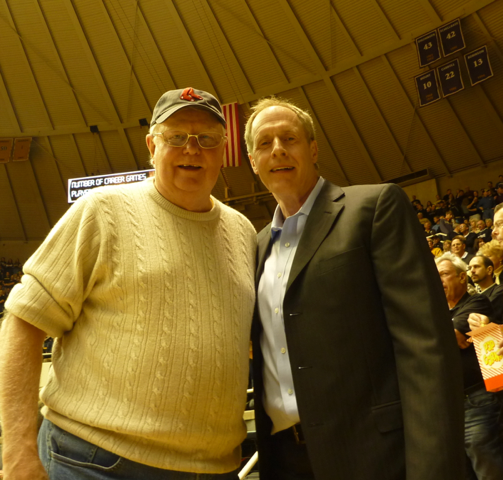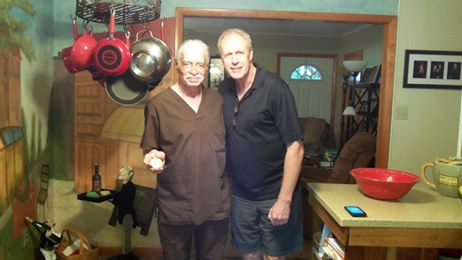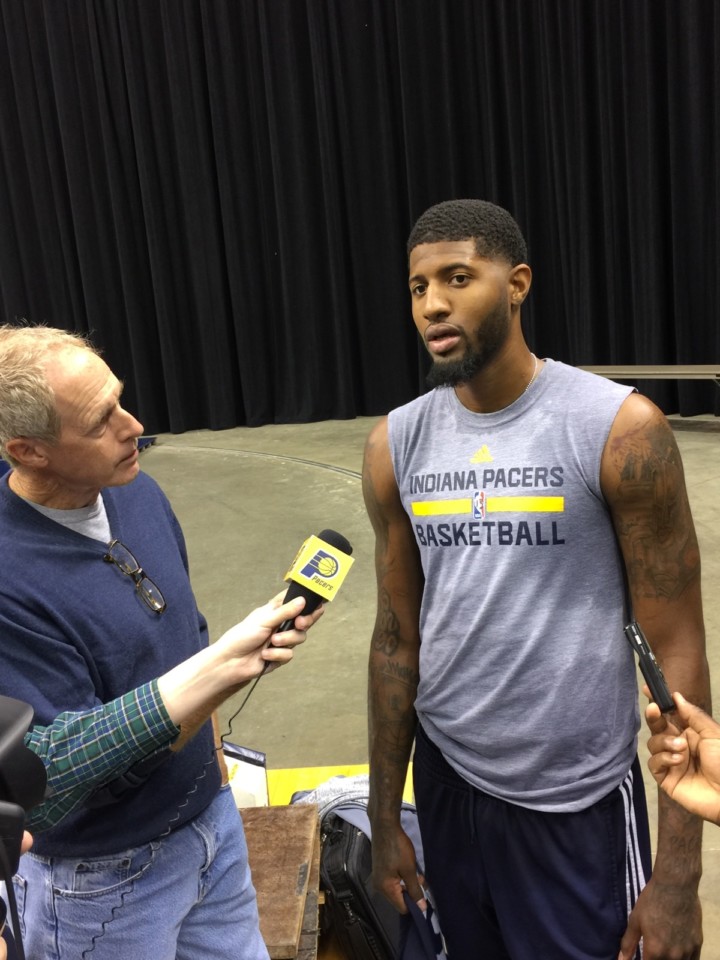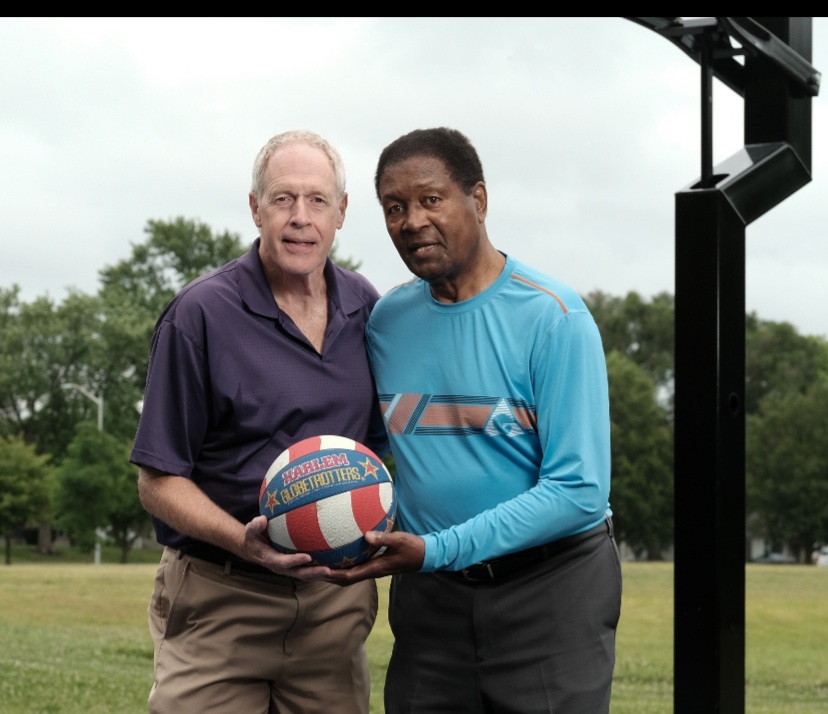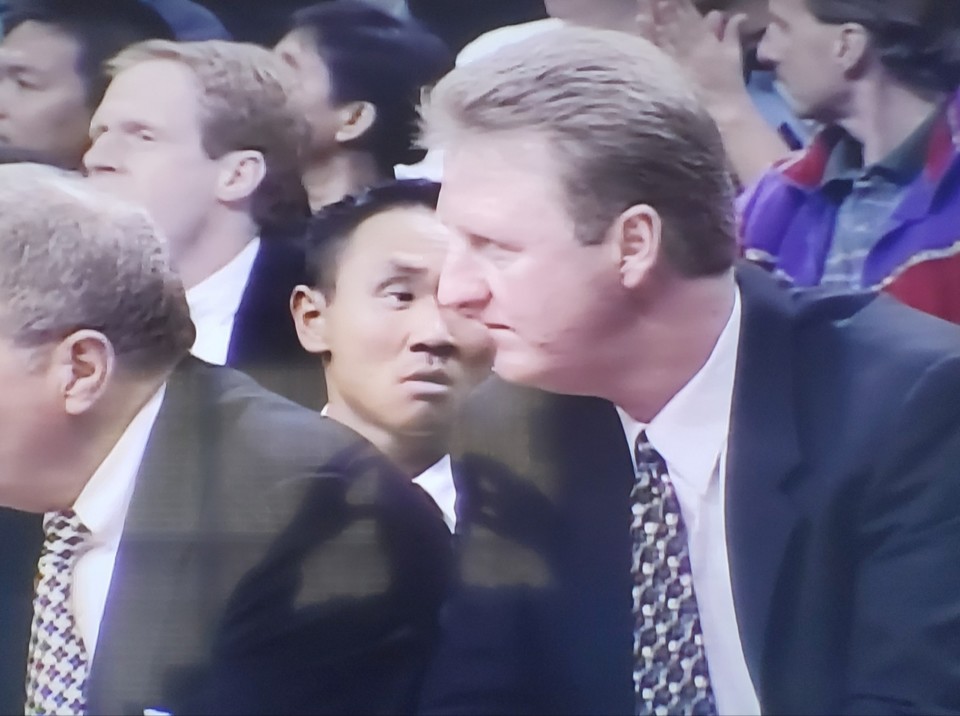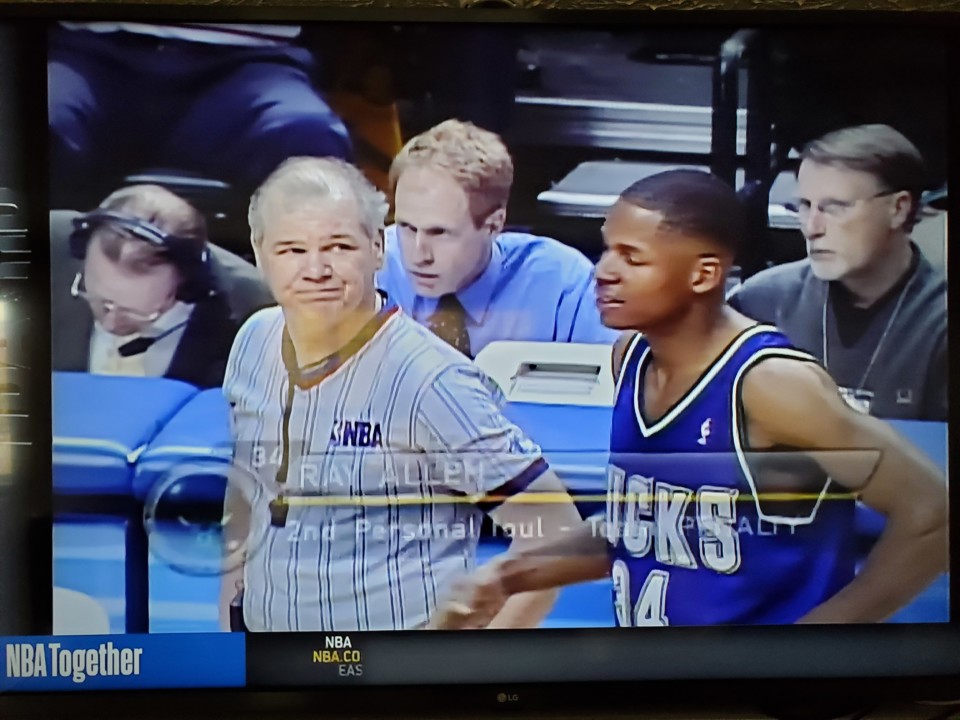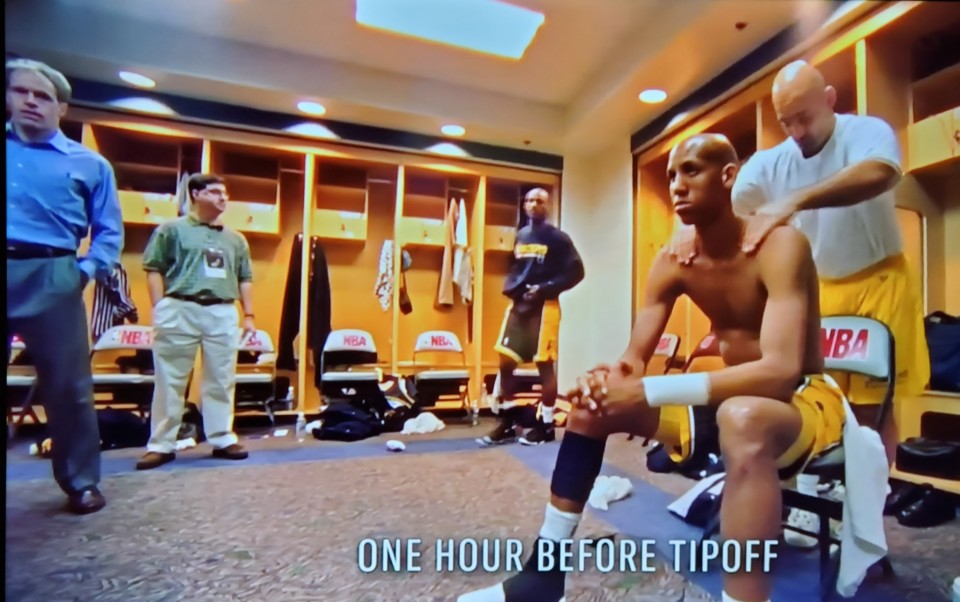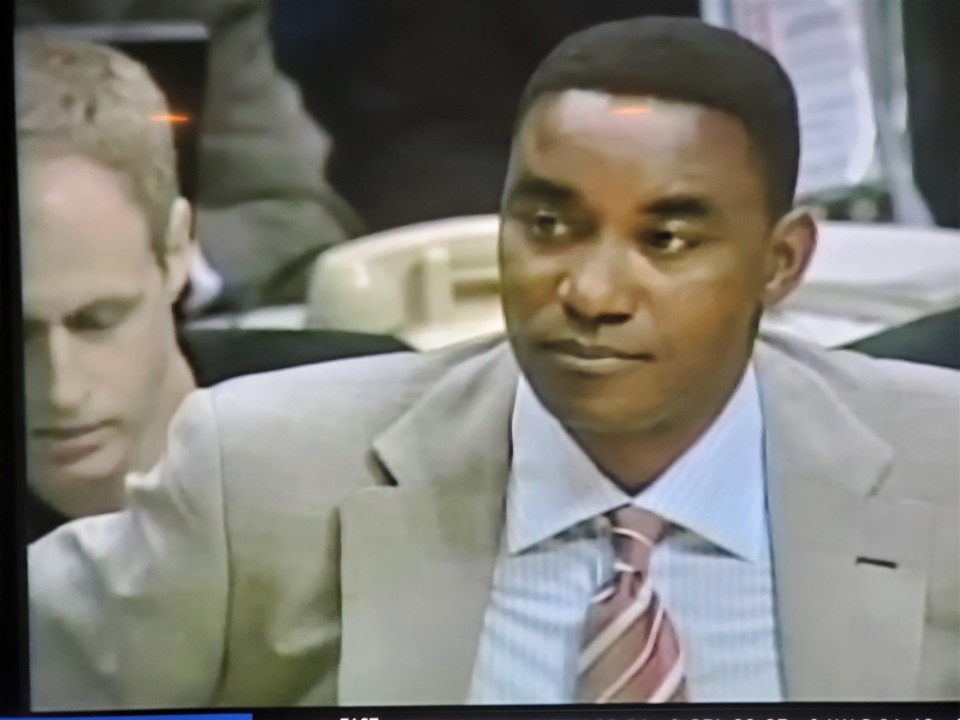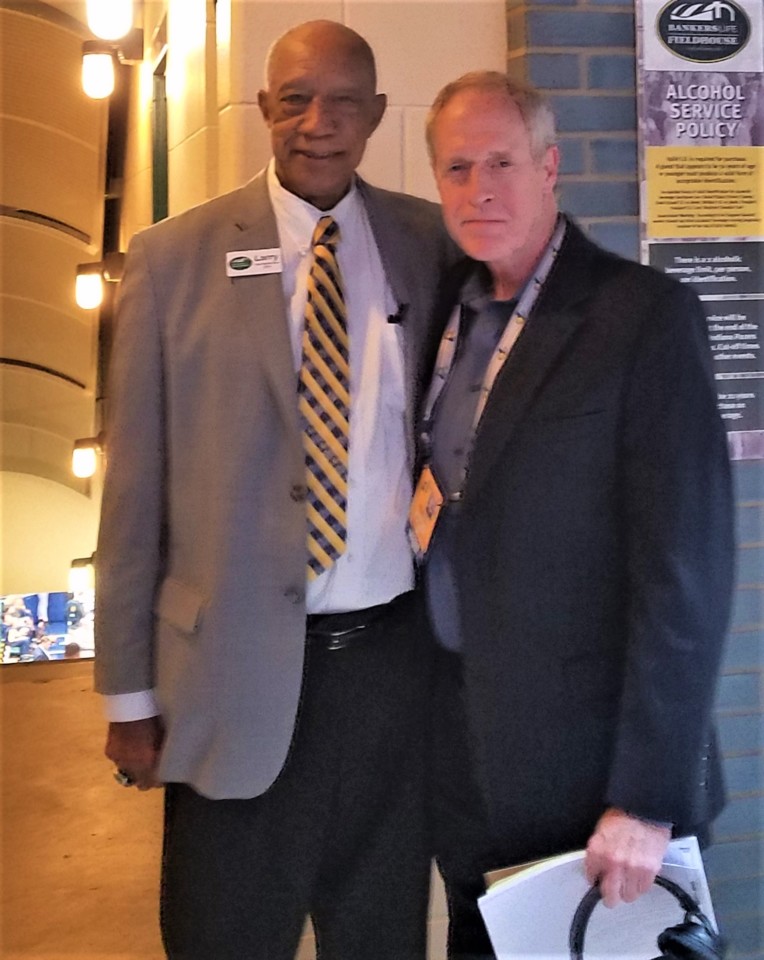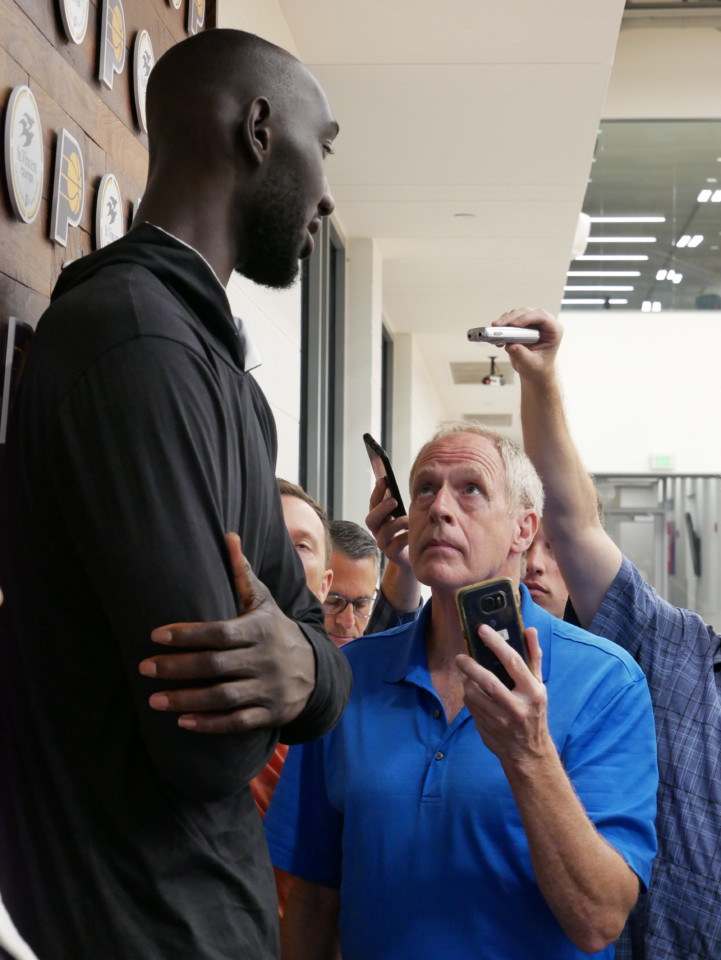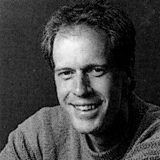(An ongoing effort, to be updated from time to time, as time and memory permit.)
I knew I wanted to be a sportswriter as a young boy. Writing came more naturally to me than anything else, and I loved sports, so what else was there to do with my life, other than play in the NBA? That goal, alas, somehow managed to elude me. Playing college basketball eluded me, too. High school basketball nearly did as well, and I was on the team, but that's another story for another day and another website.
If I was going to get into the premier basketball games without playing or without paying, I was going to have to write about them.
I loved reading the newspaper sports sections while growing up. We took two throughout most of my childhood in Indianapolis, the morning Star and the afternoon News. We even took the ill-fated Times shortly before it expired in 1965. I'm guessing now its management offered some great deal before it breathed its last in a desperate attempt to survive. So, for awhile, we took three newspapers. I looked forward to getting them, and often spread out the sports sections on the living room floor and inhaled. I'm telling you, those were exciting days over on 65th St.
I wrote for the school paper and yearbook and won some writing awards in county high school competitions, and decided to pursue a Journalism major in college. Really, I had been planning that since I was about 12 years old, and never strayed far from it despite the warning of Corky Lamm, a sportswriter for the News. He attended the same church as my family, Northwood Christian. One Sunday my mother told him I was thinking of becoming a sportswriter. He asked how old I was. She told him. "Well, then maybe it's not too late to change his mind," he said.
Classic newspaperman's answer, that one.
Corky, I later learned, had reason to be cynical, having been subjected to the sort of managerial manipulations so commonplace in the profession – in most professions, for that matter. He was a great talent, though, as a writer and cartoonist, and a good example to follow.
I ignored his advice. But I grew to understand it.
***
I began my college career at Ball State, figuring there was no other choice unless I was going to cross state borders and send my parents' tuition bills spiraling. Our high school groups had always gone there for journalism workshops and weekends, and I wasn't even aware Indiana University had a reputable program.
It only took a few weeks before I realized I was in the wrong place. I can't say why, it just didn't feel right to me. The campus wasn't small enough to feel quaint and charming or large enough to feel big and powerful. It seemed stuck in the middle, indecisive about what it wanted to be.
The journalism classes I took were uninspiring as well. Because I knew I wouldn't be staying long, I made no attempt to get involved with the school newspaper. I took my classes, got my grades, and planned to transfer to Indiana the following year because by this time I had become more aware of the program in Bloomington. With nothing better to do, I had a sudden burst of inspiration to bear down and see if I could pull straight A's the final quarter. (Ball State was on a quarter rather than semester system at that time.) I wound up just short, with three As and a B in a Geology class. I thought I had done it. It had to be a high B. In the long run, of course, it made absolutely no difference what grade I earned in a Geology class, or if I got straight As, or if I even remembered taking a Geology class.
Indiana felt more like it. The campus was gargantuan and a little intimidating, but it had a big-time college journalism department and newspaper, with a rich tradition and a travel budget that allowed sports beat writers to cover most road games. The problem was, nobody came to get you and offer you a position on the staff. At some point you had to walk into the newsroom, full of people you assumed to be smarter and more talented than you, and ask for something to do. I got around to that at the start of the second semester my sophomore year.
This was amid what can be fairly described as the golden era of American journalism, in the post-Watergate years. Standards were high. The profession was powerful, and respected by the right people. Smart kids gravitated toward it. People bought newspapers, because they were the primary source of information, and newspapers were thriving. Major cities had at least two of them. Magazines were thriving, too.
I started out writing brief items about club sports teams and the like, then stayed for summer school to get a foothold. The Daily Student put out a weekly publication in summers, which provided ample opportunity to write, edit and design pages. Summers in Bloomington were -- and are -- beautiful, and that was a good summer. Certainly better than working on a non-union crew pouring sidewalks and curbs for $3.25 an hour, as I'd done the two previous summers.
I covered the cross country team the first semester of the following school year, and then became sports editor. It was practically a full-time job, and paid the princely sum of $70 every two weeks -- enough to keep gasoline in my car, at least, and enough to get me accustomed to low-paying newspaper jobs in the real world. Nobody worked for a college newspaper for the money, though. It was about the experience, and that was priceless. The IDS was self-supporting and independent from the university. We weren't censored in any form, and we were idealistic.
My timing was good, because IU's basketball team won the national championship with an undefeated season during the semester I was sports editor. I was in charge of the department, and the only member of the sports staff willing or able to do page makeup, so I was in the newsroom five nights a week. It was basic training, which made it difficult to keep up with classes, but it was fun (most of the time). Newsrooms were loose, rowdy places in those days. College newsrooms, especially. You could laugh, sing, or yell across the room, and, when finals were approaching and stress was mounting, have eraser fights without some corporate executive wagging his finger at you. Housed within Ernie Pyle Hall in the heart of campus, next to the Student Union, it was a great place to hang out even if you didn't have work to do.
I had plenty of work to do, though. I spent Spring Break on campus that semester, putting out a special tabloid section celebrating IU's national championship virtually by myself. I didn't write the stories, but I did everything else. My idea for the cover was not executed properly, but that provided a lesson on communication within the staff. It was a lot of work and something I was proud of at the time, but had absolutely no bearing on my future career.
I got a shot at a major beat my senior year, when I covered the basketball team. My timing was horrible on one hand but great on the other, and it turned out to be an educational and unforgettable experience. I was going to cover Bob Knight, who at that time was the country's most respected, powerful and, probably, egotistical college basketball coach.
I had met Knight the previous year, after the championship season had ended, when I had gotten the urge to write a story on his assistant coaches. I'm not sure what motivated me to do it, but the sports editor didn't stop me and it seemed harmless enough. It was a puff piece, something about how even Knight needed help now and then, and these guys were the ones to do it. I talked with them all, and they were really nice to me. Then one day I marched into Assembly Hall and introduced myself to Knight, who was sitting on the court with a few of his assistants and told him what I was writing. He was polite and cooperative, and I wrote the story, which today surely would make me cringe, if not burst into tears. But I had shown initiative, at least.
I re-introduced myself to Knight before the following season to tell him I would be the beat writer, along with fellow IDS staff member John Whisler. Knight wasn't as friendly this time around. He was foreboding, in fact. He told me I didn't have a right to publish an opinion about basketball, because I was too young and inexperienced. I told him I was going to be a beat writer rather than a columnist, so it shouldn't be a problem.
It turned out to be a helluva ride. Five players from the team that was supposed to take the court that season wound up quitting: Bob Bender before the season began, Mike Miday a few weeks after it began, Rich Valavicius at semester break, and Derek Holcomb after the season ended. Another player, Billy Cunningham, a freshman who redshirted that season, left the following season, at semester break, I believe. (1)
The 1976-77 season was the only one of Knight's career at IU in which his team didn't play in a postseason tournament of some kind. It was miserable in many respects, for everyone. But it was a trial-by-fire education in newspaper journalism.
Miday blasted Knight on his way out the door, saying Knight had "dehumanized" him. He recalled going to the free throw line against Kentucky and feeling his knees shake because he was so fearful. He said he knew he needed to leave when he walked into the locker room of that game and saw Knight backing up Wayne Radford against the wall, screaming at him.
It was the first public criticism of the coach who had won the national championship with an undefeated record the previous season. As you would expect, it caused quite a stir. Whisler and I combined to report the stories, and the Daily Student copyrighted some of them because they were exclusive. I still remember Indianapolis sportscaster (and future One on One alum) Chet Coppock leading off his sports report one night by referring to an "incredible story in the Indiana Daily Student" -- the one in which Miday gave his reasons for leaving. (I've always wondered what became of Miday. He transferred to Bowling Green and played there, but I have no idea what's happened since then.)
Despite the uproar, I got along with Knight just fine that season, once we ironed out the issue that led him to kick me out of practice.
Oh yeah, that.
One day, on a Monday afternoon in the preseason, I walked into Assembly Hall to watch practice, carrying my books from the class I had just completed. As soon as I took a seat in the stands, about 20 rows up behind the Indiana bench, at the end of the court where the team was working on its halfcourt offense, Knight stopped practice and shouted, "Montieth, get your ass down here!"
I walked down, having no clue what he wanted. He met me, face-to-face.
"Is there some sonovabitch at your paper named Phil Tatman?!"
Yes.
"Well get your ass out of here and don't come back until we get this straightened out!"
I still had no clue why he was angry. I walked back up to get my books.
"I mean now!"
I wasn't intimidated on this occasion. Having played organized basketball through high school, I was accustomed to being yelled at by coaches. Besides, he wasn't mad at me.
I walked out the opposite end of the floor, past Bloomington Herald-Telephone sports editor (and future One on One alum) Bob Hammel, who was one of Knight's closest friends. Hammel subtly rolled his eyes at me as I walked out, a mild show of support for the kid scribe.
I learned the reason behind the tirade when I returned to the IDS newsroom. Tatman had written a story in that morning's paper from the previous Saturday's football game against Ohio State. This was in the fall of 1976, when the Hoosiers were mired in the depths of the Lee Corso era. They had played Woody Hayes' Ohio State team, and actually hung in there for awhile. At some point in the game, however, they had committed a crucial turnover, one that ended their hopes for the kind of stunning upset that never happened in Corso's reign.
Tatman's lead paragraph in Monday morning's paper was something along the lines of "Bob Knight threw an ashtray against the press box window."
Knight at that time watched the football games from the front row of the press box. Tatman's lead was meant to illustrate the frustration of the game-changing turnover. It was a foil or plastic ashtray, of the sort used back when people could smoke (and for that matter, drink alcohol if you brought a flask) in a college press box, so tossing it against a window wasn't a dramatic display of disgust. Still, Tatman's lead wasn't a bad way to get the point across.
Only problem was, Knight hadn't done it. The man sitting next to him, the strength coach, had. Knight called the publisher of the IDS on Monday morning and made that very clear. The strength coach called, too, to claim guilt. I had no clue, as I hadn't been there. Tatman held his ground for a couple of weeks, maybe longer, claiming he had seen Knight do it. But at some point he acknowledged he couldn't swear he had borne witness to another Knight temper tantrum. It was an honest mistake, but still a mistake -- the kind that educates young journalists.
Whisler and I, meanwhile, continued covering the team, but without access to practice. We covered the games, but didn't dare ask a question afterward, because Knight wouldn't have answered. Finally, after a Saturday afternoon game in January, Knight told us after his postgame press conference that we should come by his office on Monday -- and bring Tatman with us -- and get things straightened out.
We did. He tried to intimidate us a little, but allowed us back in his good graces. In fact, the team was leaving for a road trip that day, and we were invited to ride along on the university plane. I forget whether John or I took that honor.
I do remember flying with the team for a game at Iowa. I sat next to freshman guard (and future One on One alum) Butch Carter. I'm sure he was thrilled to have the student newspaper reporter plop next to him, but what could he say? I didn't say a word the entire flight. I don't think anybody did once the plane took off. Knight drank his specialty, a concoction of Coke and Choc-Ola.
IU lost that game, a common experience that season. Knight screamed at the team from his seat at the front of the plane most of the way home. He didn't turn and face the players, he just sat in his seat and shouted with his back to them. He singled out senior center (and future One on One alum) Kent Benson for the worst of it.
I'm absolutely sure none of the players talked on that flight.
All in all, though, I got along fine with Knight that season. As it progressed, and it became obvious the team simply wasn't good enough to compete for anything of value, he loosened up. He joked around with John and I occasionally in practice, such as the time he walked over to us in a mock-serious tone and said something like, "I just want to know, have either of you guys written anything either accurate or informative this season?!" We were taken aback and stammered for awhile before realizing he was putting us on.
I later learned he had resumed communication with us because we had gone to the trouble of getting supportive comments from former players when reporting on the those who were leaving. We gave both sides of the story, quoting people such as (future One on One alum) Tom Abernethy, who said the key for players was to listen to what Knight was saying and ignore how he was saying it.
After the season's last game, in Assembly Hall, which Indiana won, I walked into the locker room to shake hands with Knight and say thanks. I'm not sure why, exactly, but he commanded that kind of respect from a college kid in those days. He said I'd done a good job. Even then, that kind of compliment from a coach made me a little uncomfortable, but part of me was pleased to hear it. It had been a great experience, and ideal preparation for entering the real world of journalism. From that point on, all my relationships with the coaches I covered would seem easy by comparison. Except, on occasion, the times I covered Knight's teams again.
***
I finished college later that semester, after taking a three-week intensive course in Sociology to qualify for my degree. After that, in June of 1977, there was nothing left to do but go home. Without a job. My parents were worried they had wasted their hard-earned money on my education, but in June I got a call from the Chronicle-Tribune in Marion, Ind., and was offered a job after an interview. It wasn't a glorious start to a professional career, nor a lucrative one, but it was a start. Not to mention the only option. The weekly pay was $150. After three months they either fired you or gave you a raise to $165. After a year, your salary was bumped up to $175. On payday, many of the reporters immediately walked from the newsroom to the bank to deposit their checks. There were bills to pay.
I worked there from June of 1977 to November of 1978. It seemed longer, truthfully, but not because of the newspaper. It was the town ... or the city ... whatever you want to call a place with a population of about 25,000. Marion was neither, really. It lacked the attractions of a bigger city and the charm of a smaller town. It was just a place to work and leave on days off, if possible. I joined no health clubs or organizations, didn't bother finding a basketball or softball league to join and made no friends outside the newspaper's staff.
I started out renting a freestanding one-bedroom house behind a larger home, for $125 per month. I then moved into a large two-bedroom apartment within a large complex with another reporter, Willie Wofford. The rent there was $180. Split two ways, it was affordable. For three months that second summer, we let an intern from Northwestern live with us, too. He slept on the sofa in the living room and we all paid $60 per month. That was slightly more than one-third of our weekly paycheck, so it was a bargain. I actually was able to save some money, and, on a whim, bought a 1964 red convertible Corvette for $3,500. I borrowed $1,000 -- either from my oldest brother, Dave, or my father -- and depleting my savings for the rest. It wasn't the smartest financial move of my life, but it worked out in the long run because I sold the car for a profit about 10 years later. By then it had become a nuisance. I didn't want to leave it in parking lots and it wasn't comfortable to drive. It just looked good.
Amid such humble surroundings, the Chronicle-Tribune staff was impressive. It was the first paper in Indiana to have an offset press, and therefore the first to run color photos. I started about the same time as four other recent college grads -- two from Northwestern, one from Missouri and Willie from Ball State. Three went on to jobs at larger publications and the other could have if she hadn't decided to marry and stay in Marion. After marryin' in Marion, she gave up newspaper journalism for another glamorous profession, nursing. You know how they describe small boxers as "pound for pound the best in the world."? I thought our small staff in Marion was pound-for-pound the best in the state.
I was part of a three-person sports staff at first, but it grew to four. The sports editor, Jack Lake, was a newsman from a bygone era. He was a small, wiry fellow, probably about 5-6 and 135 pounds, with a crewcut and a great sense of humor. He was a throwback. He smoked unfiltered Camel cigarettes in the newsroom, and fought the move from typewriters to computers for as long as he could hold out. He also had an outdated way of covering games. He saw no reason to talk to any of the participants; he just described the action and left it at that.
He had a difficult time adjusting to modern methods. Once, he had been sent to Cincinnati to cover the Reds of the Big Red Machine era in a playoff game. The wire service would provide a game story, so he was told to engage in what for him was a bold experiment: write a sidebar. That meant finding an angle to pursue, either from a star player or crucial play in the game, and develop a story from that.
It would require talking with people afterward, but he wasn't about to go in for that newfangled way of doing things. He wound up trying to construct a flowery article on the game, tossing in as many clichés as possible, and then dropped the final score into the last paragraph: "The final tally was ..." He stubbornly refused to go to the locker room and get quotes. The sports writing world was moving on, and he didn't want to go with it. Back in the newsroom, editors could only shake their heads.
The only two sports beats at the paper were to cover Marion High School or all the county schools. Jack had Marion, so the other staff members and I took the rest, when we weren't doing page makeup. That meant heading out to the likes of Madison-Grant, Oak Hill, Mississinewa, or Eastbrook high school, or, on a rare occasion, to Marion College or Taylor University, and then rushing back to the newsroom to bang out a story. I didn't enjoy it. I had been exposed to major college sports at IU, and this was a letdown. But it was needed experience, and it paid.
My 17 months in Marion included the worst conflict I would ever have with a coach. Some football players from Mississinewa had been suspended for a game. I was assigned the story. I called the coach, a good guy named Del Jarman. He told me he couldn't tell me the reason for the suspension, that he had to protect the students. We continued talking, and he eventually told me they had been drinking at a party. I wrote the story, and reported that. He was angry, thinking I had violated a trust by reporting what he considered off-the-record information. I, on the other hand, thought I had pulled a Woodward and Bernstein on him by doggedly extracting the information. Bottom line, it was an honest misunderstanding, and there were no hard feelings after it blew over. Another lesson learned.
I wrote few stories during my time at the C-T that I remember. I convinced Jack to let me find (future One on One alum) Rick Mount and write a story. Mount had recently retired from his playing career in the American Basketball Association, and was working at an outdoors store in Lebanon, on the town square. I called to set up an interview, and he agreed. I would later realize he didn't do that very often. I talked with him at his store.
Mount had been a major star to a lot of boys my age. He was on the cover of Sports Illustrated as a senior in high school in 1966, the first high school athlete from a team sport to be so featured. He became an All-American at Purdue, where his legend grew, but his pro career had not worked out. He had signed with the Pacers, but was not a good fit for the coach, Bob "Slick" Leonard. He played for a few other teams, but injuries kept interrupting his progress. He tried one last time with the Pacers, but had walked out of training camp in 1976 and retired.
He was a forthright interview subject, venting his frustrations, and the story generated about as much response as a story in a 22,000-circulation newspaper could generate. Back in those days, readers had to write a letter to seriously respond to a story, and I got a few.
***
I eventually got a reprieve from Steve Jacob, an associate editor of The Journal-Gazette in Fort Wayne. He had been the publisher during my final semester at the IDS, so we were familiar with one another, and he invited me up for an interview. I eventually was offered a job, covering the county high schools in that area. My pay skyrocketed to $227.50 per week. It seemed like a lot of money at the time, although I never did understand how they came up with the 50 cents. Had they thrown in an extra two quarters per week, or deducted them?
I filled an opening created by the firing of the sports editor, Larry Stephenson, a legend to anyone who knew him at that time. He was let go because he had rolled up a gambling debt to a local bookie who also owned an auto racing track, and was paying it off by writing favorable columns about the track and its events. Stephenson was an odd guy, to say the least. I heard he sometimes wore glasses with no lenses, not even clear ones, apparently to look smarter. Throw in the fact he taught Sunday School at his church each week, and you have quite a character.
Ever think it's cruel that people who are laid off or fired are immediately escorted from their workplace? Here's why it happens.
Stephenson came in the morning after he was fired to clean out his desk. He logged on to his computer for a minute, which seemed a strange thing to do. Late that night, as the papers began rolling off the presses, one of the sports staff members, George Honold, happened to check out the softball notices on the Scoreboard page, where standings, box scores and notices are published in agate type. George had written one about a call-out for a tournament, and wanted to make sure it had been included.
Within the small type of one of the notices were these words: "Larry Stephenson is a c---s----- and a m-----f-----." Stephenson's plan, apparently, was to accuse someone at the paper of doing the dirty deed and file a lawsuit. Honold called the offending notice to the attention of the makeup person, who called either the editor or publisher at home, who ordered that the presses be stopped. Yes, occasionally there was such a thing as "Stop the presses!"
Police officers were sent out to track down the delivery trucks that had already left the building, full of newspapers with the most memorable softball notice in the history of journalism. The trucks returned, the newspapers were destroyed and the Scoreboard page was re-edited to be made suitable for public viewing.
One sports staff member, Jay Margolis, had the foresight to clip the notice, laminate it and carry it in his wallet. I saw it. It was amazing that someone would even think to do such a thing, and even more amazing that someone would try to pull it off. How would he have explained that in Sunday School?
Such was the job market in the late Seventies that Stephenson was able to find another job. And another. And another. He hopped around the country, and kept getting jobs as a sports editor. He had experience, he knew how to cover up damaging information about his past and the hiring editors didn't bother to do background checks. His next job was in Wilkes Barre, Pa., where he crossed a picket line. One of his later stops was at a Las Vegas paper. His introductory column included a sanitized recount of his career and included a comment along the lines of, "When I left Indiana, my good friend Bob Knight told me to ..." He had never met Knight, to my knowledge, and they certainly weren't friends. (2)
Interesting times.
After one season of covering high school basketball in the boondocks surrounding Fort Wayne, I became nearly a full-time makeup person. Nobody else seemed to want to do it, and I liked it better than covering the area high schools. Nothing against that sort of thing, I just didn't enjoy it. You covered different teams each week so you had only superficial knowledge of the teams you covered, and filing stories was difficult. You either had to set up in an athletic director's office or rush back on country roads to the office. It took years off your life.
I worked the desk Tuesday through Saturday, and put out the Sunday sports section with minimal help. Page layouts were sent upstairs via pneumatic tubes. It made for a lot of evenings of running up and down stairwells to go back and forth between the newsroom and upstairs composing room. It was a challenge, and fun most of the time. The adrenaline rush of meeting a deadline made it exciting and being able to hold your night's work in your hands afterward was satisfying.
I worked mostly with a pencil-thin printer named Joe Oberlin. He was a bona-fide alcoholic and really funny, most of the time. He might be a little crabby early in the evening, but after he took his dinner break and walked across the parking lot to Henry's, the bar/restaurant that catered to newspaper employees and gays, he was in fine spirits the rest of the evening. He performed his job better, too. He talked a lot of nonsense and sang silly songs, twisting the lyrics of popular tunes of the day, but we had a good time most evenings. He called me "Small Walt," because he thought I looked like Bill Walton, only about a foot shorter.
He was my first close-up encounter with an alcoholic. And he wound up dying young, after I had left Fort Wayne, as a result of his condition.

During my time working makeup, I had my most memorable fan experience. On a day off, a weeknight, a fellow staff member, Doug Haberland, and I drove to Chicago to catch a White Sox game. We had no idea of the special promotion they were running that night, we just wanted to see a game. As we were looking for a parking place we noticed fans walking toward the stadium, holding record albums. They weren't conventional fans, either. They looked more like leftover hippies from the previous decade.
It was Anti-Disco Night, the brainchild of a Chicago radio station. The plan was for fans to bring disco records that would be collected and blown up in the outfield between games of the doubleheader. It didn't quite work out that way. The fans began flinging the records at the outfielders, who took to wearing batting helmets to protect themselves. They did indeed blow up the records between games, but fans stormed the field and the second game of the doubleheader was cancelled. It was unforgettable, but not my most memorable experience at a game, it would turn out.
Eventually, I was allowed to escape the office and cover the football and basketball teams from Indiana and Purdue. I wrote as much as possible, going to games home and away as long as they were within driving distance of Fort Wayne. Fortunately, most of the Big Ten schools were. Later, I was allowed to fly to games as well. The economy was strong, the newspaper was doing well, and IU and Purdue were among the best in the Big Ten in basketball -- and were at least competitive in football most years.
This meant a lot of three-hour drives to Bloomington and two-and-a-half-hour drives to West Lafayette, not to mention jaunts to other Big Ten cities. This was in the glory days of the conference, the Eighties, when the Big Ten actually consisted of 10 teams, and most of them were really good at various points, so it all seemed worthwhile. I ate it up, getting to as many games as possible.
I once covered a basketball game at Purdue on a Saturday, then drove back to cover another on Sunday when they played Syracuse on national television in a break from their Big Ten schedule. It got so I could time the drives perfectly. I'd go to the YMCA and play basketball and work out, then drive to Bloomington and arrive as the national anthem was being played. Then I'd drive home, arriving about 2 a.m.
The speed limit was 55 miles per hour on the interstates then, and I got so many speeding tickets in my 1977 Oldsmobile Cutlass that I had to go to driver's school to keep my license. Twice, actually. When you're driving home at 1 in the morning on a cold winter night, and the roads are practically vacant and you're so tired you're rolling down the window occasionally to get a blast of cold air to stay awake, you tend to driver faster.
Besides, I tended to drive too fast anyway.
I had a lot of great work opportunities in those days. I covered the Final Four in Indianapolis in 1980, when Purdue was among the participants, and IU's run to the national championship in 1981. I reported on most of its regular season games and all of the NCAA tournament games.
I was one of the geniuses who bought a Video Cassette Recorder when you had to pay $1,800 for a decent one. Among my first recordings were IU's Final Four games in Philadelphia. If you look closely at the semifinal game with LSU, you can see me taking my seat at the start of the game in the upper-right corner of the screen before the start of the game -- although I can't imagine why you would bother.
I thought it was amazing you could record a television program, and I looked forward to accumulating a library of games on video tape. I couldn't have imagined how quickly that technology would become outdated, or, for that matter, how cheaply you would be able to buy a VCR one day. Not to mention a DVD player and recorder. Not to mention an internet connection so you could look at YouTube videos.
The Journal-Gazette alternated sponsorship of the all-city basketball and football banquets with the afternoon paper, the News-Sentinel, in those days, and it was our turn to do basketball in 1981. It was to be conducted one week after IU's championship win over North Carolina, and by prior arrangement we got Knight as our guest speaker. Knight was friends with the Journal-Gazette publisher, a good man named Dick Inskeep. Knight did it as a favor to Inskeep, and also as a boost to his recruiting efforts in Fort Wayne. One of his recruits for that year, in fact, was a member of our all-city team, John Flowers.
Knight, though, made it seem like he was speaking at the banquet as a favor to me. That was one of the ways he tried to manipulate the media. He'd offer a favor here and there and expect them in return. He wanted you to play ball with him, so to speak. You were either with him or against him, in his mind. There were small rewards for being with him, such as an exclusive interview now and then, but a price to pay, too. You would be expected to ignore or downplay the controversies. Write something he didn't approve of, and you were out.
I tried my best to stay out. He was the all-time master of manipulating reporters. I even remember hearing him joke about it on media day in 1976 before the season I covered his team for the IDS. He did it, he was good at it, and he knew it. And it worked to a large degree. Some people thought the media was out to get Knight throughout his career at IU, but it's closer to the truth to say he got away with plenty by manipulating the media. And winning, of course.
I was assigned the task of introducing Knight at the banquet. I was uncomfortable with it because it didn't seem an appropriate thing for a reporter trying to maintain objectivity to do, although I also was a part-time columnist at the time. The publisher sent word that I was to do it, though, and I was in no position to argue. I wouldn't be surprised if Knight had told him to have me do it as a way of building a connection.
I kept it brief and simple, stating Knight obviously needed no introduction, giving his overall coaching record and pointing out the most recent victory had brought a national championship. It took 15 or 20 seconds. Knight got a standing ovation. I sat down.
"Thank you, Mark," he said. "I was surprised by the accuracy of your introduction. Someone else must have written it for you."
It was a good line for a coach who loved to take jabs at the media, and it got a good laugh. I give him credit.
Later that year, in December, I took a few vacation days and went to the Bahamas to cover Muhammad Ali's final fight against Trevor Berbick. I got a credential and paid all my expenses, but was given a nice favor by Billy Reed of the Louisville Courier-Journal, who let me use the spare bed in his room. I attended the fight and reported on the press conference the final morning. It was a sad way for Ali to go out, but I wanted to see him fight in person. The press conference the next morning was unforgettable, and the story I wrote is included on this site. It won an award of some sort, but I give Ali most of the credit. He made it easy, given the material he provided.
I stayed a couple of days after the fight to use up vacation time. One night I was walking through a hotel and passed a beautiful woman. By then I had learned to spot the hookers. She asked me if I wanted company. I was curious about the going rate, so I asked. She said $700. I told her I'd take her to dinner instead. I was curious about a lot of things related to her life and profession. I was ready to interview her, I guess, although not to write about it. Needless to say, she didn't consider that efficient use of her time.
I had another memorable basketball banquet moment two or three years later, when former Purdue and then-Pacers guard Jerry Sichting (also a future One on One alum) was our guest speaker. He drove up from Indianapolis for the occasion. Rod Woodson, better known for his football talents, was one of the members of the all-city team that year. He didn't have great basketball skills, but his elite athleticism helped make up for it.
Sichting spoke for about 45 seconds. Seriously. He made a little joke with Woodson about how much he had eaten, made a few remarks, looked at his prepared notes, seemed to lose his place, and stopped. It was as if he said to himself, "Screw it, I'm ready to go home."
Everyone was stunned. I should have had the presence of mind to jump up and take questions from the audience but didn't. Sichting had driven two hours to speak for less than a minute, and was paid between $200-300. Thank you everyone, drive safely! At least he didn't bore anyone. Several of the kids on the team got his autograph, so they got something out of it. Jerry's a great guy, and I got to know him much better in later years. He probably doesn't even remember the evening.
The Journal-Gazette hosted the all-city football banquet in 1983, and IU football coach Sam Wyche was the speaker. He was coming off his first, and what turned out to be only, season in Bloomington. I sat next to him at dinner, and the conversation turned to football uniforms because Wyche had introduced unique ones at IU. They were actually cream and crimson, the official school colors, rather than basic red and white. Most people thought of them as ugly, but they were at least unique and a reflection of Wyche's creative mind. The Cincinnati Bengals had introduced their tiger stripe helmets the previous season, so I asked Wyche if he liked them. He looked at me funny and said, "Why do you ask that?"
Just asking, I said.
Within a week, he was announced as the Bengals coach. He knew at the banquet he was going to be taking that job, so he wondered if I knew something. I didn't. I give him credit for fulfilling his promise to appear at the banquet. I covered his introductory press conference in Cincinnati, and we laughed about it.
***
I really enjoyed living in Fort Wayne. My job was going well, and I had friends inside and outside the newspaper. I was playing in softball leagues, playing basketball at the Downtown YMCA, and running. I ran a 10k downtown (40:10) and a four-mile race (24:40) through Foster Park. I finished 24th in that one and got my name in the paper as one of the top 25 finishers. I got a kick out of that. Having a byline was nothing special by that point but earning a place on the Scoreboard page felt better. And Larry Stephenson was no longer around to interfere with the agate type.
The Downtown Y was a great place then. Memberships were dirt cheap, although I can't remember the dollar figure, and there were plenty of places within the old building to work out or play basketball. It was part of my routine to get in a workout there before going to the newspaper office late in the afternoon to begin laying out the paper, or before leaving town to cover a game. I got to where I had it timed perfectly. I could play basketball at the Y, squeeze in one more game, shower, drive three hours to Bloomington and walk in during the national anthem.
I nearly had one of my most embarrassing experiences on a basketball court one day there when I played into a two-on-two game. My teammate, whom I had never met, was getting beat consistently for layups and was limping a little. I thought he had a sprained ankle. We were getting beat and I was getting angry. I nearly said something like "Hey, if you're hurt, go sit down, this is ridiculous."
Fortunately, I didn't. After we lost the game he walked to the sideline, sat down and took off his artificial leg. I would have asked him to beat me over the head with it if I had said what I had been thinking. A good lesson there about keeping your mouth shut when someone is struggling.
Some people lived at that Y. One of them was a mentally handicapped, overweight young man who passed time by shooting baskets - for hours and hours. He roped me into a game of H-O-R-S-E one day and drilled me. I can shoot a basketball, but this guy was unbelievable. He was throwing in hook shots from 25 feet, one-handed heaves from midcourt, all kind of wild flings that he practiced. Worse than that, he laughed and cheered uproariously every time I missed and got a letter. And there wasn't a damn thing I could do about it. I kept my mouth shut then, too.
***
I left Fort Wayne for Indianapolis in 1984, after the Colts made that dramatic trip over on the Mayflower trucks. As much as I liked living there, I had been pushing to live in Indy for a couple of years, arguing it would save the newspaper considerable money in mileage reimbursement. I could work out of my home, so no office rental would be necessary, and I could pick up the bigger events in Indianapolis, too. The tipping point came when the afternoon News-Sentinel announced it was putting a Colts beat writer there. That helped persuade my editors to do the same.
Moving back to Indianapolis was great since I had grown up there and my parents and one of my brothers still lived there. It was the perfect job location, too. I was two hours from the newspaper office and had access to far more teams and stories. I was an hour from Bloomington instead of three, an hour from Lafayette instead of two-and-a-half and about 20 minutes from covering the Pacers and Colts games.
I covered the Colts home and away their first year in Indianapolis, primarily as a feature writer rather than a beat writer. I would fly to the likes of Houston, Dallas and Miami on Thursday, talk with an opposing player on Friday and write a feature story for Sunday.
As you can imagine, NFL stars weren't all that excited about giving much individual time to a writer from a Fort Wayne, Ind. newspaper, but I got some time with the likes of Warren Moon, Danny White and Dan Marino. I'll never forget Marino's first words to me when he came out to meet me after practice: "Can we make this quick?" I tried to oblige, but got enough to write something. I was given a few one-on-one minutes with Dolphins coach Don Shula, too. Looking back on it now, it seems amazing I received that kind of consideration, but the media environment in that pre-internet era was much simpler and more open.
I had another memorable banquet experience that year, too.
The editors in the newsroom in Fort Wayne wanted a Colts player to speak for our all-city football banquet in 1985, and I was able to persuade offensive lineman Chris Hinton. He was smart and polished, a Northwestern grad and an all-pro player. He said yes readily, but on the day of the banquet began talking as if he wanted to back out of it. He was searching for excuses, such as claiming a teammate had told him Fort Wayne was a lot farther than a two-hour drive, as I had promised. Fact was, he had stage fright and the idea of driving two hours with someone he didn't know well to speak at a high school banquet didn't seem appealing. But he was too responsible to back out. I rented a car nicer and larger than the one I owned so he'd be comfortable and drove him up after practice. We arrived at the banquet barely in time, bursting through the doors about the time people were doubting we were going to make it.
He opened his talk with a joke, which he recalled in our One on One conversation. It went over well, and everyone breathed a sigh of relief. Him included. I wasn't thinking about it at the time, but was reminded later he was the first pro athlete to speak in Fort Wayne since Isiah Thomas had made a rather memorable appearance at a charity golf tournament less than two years earlier. Some people apparently were fearing another embarrassing episode. When Hinton delivered the punch line, a clean one, you could almost feel the relief in the room.
Hinton, who had dozed off on the way to Fort Wayne, was practically giddy on the way back to Indianapolis. His hesitation had been the result of nerves more than anything. It helped me realize even established pro athletes have insecurities - about public speaking, among other things.
I wound up covering most of the Chicago Bears' run to the Super Bowl championship that season. About halfway through the season, when it appeared they were on their way to something special, I switched over from the Colts. They, after all, were new to the state while Bears fans were entrenched throughout Indiana. On many weekends I'd cover an IU or Purdue game on a Saturday then drive to Chicago for the Bears' game the next day. I'd arrive at the Downtown Marriott on Michigan Ave. about midnight, wake up early, have breakfast and head to Soldier Field. You might think of that as a horrible way to spend a weekend. I thought it was great. I was getting paid to go to sporting events and I was racking up Marriott points like crazy. For sportswriters and other business travelers, they were currency, something to brag on to prove how much you traveled on the company dime.
One night the only room available when I checked in was one of the larger suites on the top floor of the hotel. It included a bedroom and massive living area with a grand piano, and had as much square footage as some houses. I might as well have been staying in a closet, though. All I had time to do was go to sleep, wake up, eat and leave. A lost opportunity, it seemed.
I covered a few of the Bears' road games that season, too, including their only loss of the season at Miami. It was a Monday Night game, two days after Gerry Faust's final Notre Dame team had been humiliated by Jimmy Johnson's University of Miami Hurricanes. I covered that game, too. Salad days for me, you could say. I rode up the elevator to the press box afterward amid a group that included Johnson. Someone told him Faust had complained about him running up the score. He had no sympathy whatsoever, having been on the other end of blowouts such as that.
The Bears, meanwhile, took their loss on Monday in stride. Going undefeated hadn't been a goal, and it truly didn't matter much to them.
What I remember most about that weekend was my trip to Key West. I woke up that morning and decided it would be a good way to spend a few hours, so I hit the road with everything I would need to cover the game that night. I hadn't majored in Geography in college, so how was I to know it was more than a three-hour drive from Miami? I thought it was 30 or 40 miles. I was committed to getting there, so I kept going even after I saw the mileage signs on the highway. I arrived, got out of my car and looked around for about five minutes, and then rushed back to Miami. I barely arrived at the game in time for the kickoff.
That didn't matter, though. Many games, you don't need to be there for the start. One time in the early Eighties I was driving from Fort Wayne to Purdue for an Old Oaken Bucket game. Running a little late, I was rushing along Highway 24 or 25, in a section that was just a two-lane road. I tried to pass a car, but didn't have time to get around it before hitting the oncoming car. The car I was passing wouldn't even slow down to give me room. I had no choice but to bail out in a ditch on the opposite side of the road. My car wasn't damaged, but I had to call for a tow truck to get out. I arrived at the game at halftime, much to the consternation of Purdue's Sports Information Director, Tom Shupe, and much to the amusement of fellow sportswriters.
It didn't make a bit of difference. The game went down to the final play when Lee Corso's son, Steve, failed to catch a two-point conversion in the end zone, allowing Purdue the victory. That obviously was the story.
I once made an exceptionally late arrival to a game as a spectator, too. John Whisler and I had decided to go to a Yankees game at Tiger Stadium, on Sunday, Sept. 18 in 1977. We were both a few months into our newspaper careers, I in Marion and he in Plymouth, Ind. I picked him up at his apartment at the appointed hour. He was still asleep, having been up late the previous night covering a high school football game. John's a great guy and a talented writer (now working in San Antonio), but also laid-back. He isn't one to hurry. So we got a late start. On the way up, we realized there was a time difference between Detroit and Indiana, so the game was starting an hour earlier than we thought. Then we realized we had misjudged the amount of time it would take to get there.
Long story short, we listened to the game on the way up and arrived at Tiger Stadium in the bottom of the ninth inning. At least we got in for free at that point. The Yankees led 6-0. Detroit scored five runs in the bottom half of the inning and was threatening to score more. John and I were both Yankees fans, but we were begging the Tigers to tie the game and force extra innings. It didn't happen. We saw half an inning of baseball and headed home.
Just two kids fresh out of college, too dumb to plan ahead.
***
The highlight of my sports coverage in the Eighties was the basketball rivalry between Indiana and Purdue. IU won the Big Ten title in 1980, '81 and '83. Purdue won it in '84. The two shared the championship in 1987, when IU went on to win its third national title. Purdue won it in '88, and IU in '89.
IU nearly always -- maybe always -- had more talent than Purdue, but the coaches took similar approaches. Some of those seasons, both teams made more foul shots than their opponents attempted, a tribute to their shot selection and self-discipline. Knight and Gene Keady were as fiery as any coaches in the history of college basketball, and their fans were swept up in the emotion.
Their games were case studies in mob mentality. When Knight was ejected after throwing the chair in the game against Purdue in Assembly Hall in 1985 for example, fans reacted by throwing coins on the floor late in the game when it was obvious Purdue was going to win. One of them ricocheted and hit Keady's wife, Pat, in the eye. She left Assembly Hall wearing a patch. I reported that, as did some other reporters. Knight denied it on his radio show the following Monday, but apparently had been misinformed.
I can't even describe the noise level when those teams played one another. The games in Mackey were loudest for two reasons. Mackey Arena is a smaller building than Assembly Hall, so the noise reverberated more. And, in those days fans had to sit on bleachers rather than in cushioned chairs such as they had at Assembly Hall. I recall times in Mackey during a Purdue rally when the noise was so deafening I would look at whomever was sitting next to me just shake my head.
The peak year for the rivalry, to this day, was 1987. That was the year they tied for the Big Ten title, and they could hardly have been more evenly matched. Each team won by 11 points on its homecourt. For the second of the two games, in Mackey, all 10 starters were averaging in double figures. I wonder if that's ever happened in another college game, particularly involving two teams that emphasized shot selection and defense. As closely matched as the two teams were, however, their seasons ended in sharp contrast. Purdue lost in the second round of the NCAA tournament in an ugly game with Florida State. Indiana won it all.
***
John Feinstein's book, A Season on the Brink, had created a sensation when published in 1986. People were shocked by the inside look at Knight's tantrums during that difficult season, but supporters found plenty in it to support their belief in him.
I had the bug to write a book, too, as a professional challenge. Purdue had four starters returning from the team that tied for the Big Ten title in '87 and had a legitimate opportunity to contend for a national championship the following season. I approached Keady about doing the same thing Feinstein had done - spending the season with the team with total access and documenting it. He readily agreed.
I had no illusions about matching Feinstein's sales, which made him a millionaire. Keady simply wasn't as dramatic (some would say crazy) a figure as Knight, who couldn't have been imagined by a fiction writer. I wanted to spread the focus throughout the players and coaches, capturing the agony and joy of a college season, and the pressures on them all.
My editor at The Journal-Gazette, Craig Klugman, agreed to give me a leave of absence to write the book, a favor I appreciate even more in hindsight. Not many editors would let their only sports columnist take a leave to write a book. I was paid half my salary to write a column for each Sunday's paper so that I could survive. I rented out my condo in Indianapolis and rented a two-bedroom apartment in a large complex in West Lafayette.
That Purdue team went on to win the Big Ten title by two games, but lost in the third round of the NCAA tournament, to Kansas State. It seemed an upset at the time but not so much in retrospect. Mitch Richmond, who banked in a three-pointer from the top of the key in that game (always a bad omen), was voted the NBA's Rookie of the Year the following year and went on to be named to the Naismith Hall of Fame. Another K State player, Steven Henson, played in seven NBA seasons as a backup point guard. Purdue had no player who came close to matching those feats, so maybe the best team won.
Regardless of the unhappy ending, it was a great season and a great experience for me. It was like running a marathon, something I had done in Moscow in 1985: grueling, but satisfying after enough time passed. The winter of 1987-88 is a marker for me. I'll always remember what I did then, and it's practically a dividing line for my career, sort of the point where B.C. turned to A.D. Writing the book was a major challenge, it sold well, it was highly praised in reviews and I learned a great deal about basketball and the people who play and coach it. I felt like I had earned a graduate degree in covering the sport from being able to see the game from the inside, and that knowledge has stayed with me.
It didn't help my newspaper career, though. I had been a full-time columnist when I took my leave of absence. Once I was ready to return to work full-time after completing the book, I was told I would have to move back to Fort Wayne to maintain that opportunity. I could understand the argument of having the columnist live in the city where the newspaper was published, but I had been promised the opportunity to stay in Indy a few years earlier when I had turned down a job offer from a larger newspaper. I was told then I was being paid all the money they could pay but that they were committed to me as a columnist and to having me work out of Indy. That was good enough for me, because I was loving the job. I had won first place in state column-writing competition in the only year I had been a full-time columnist and was looking forward to continuing to improve.
I wound up giving up the column and going back to covering Purdue as a beat reporter in order to stay in Indy. That was enjoyable, too, and easier than ever because of the connections and knowledge I had gained from writing Passion Play, but it still was a disappointment. I felt betrayed.
I stayed in that role for two seasons, filling in by covering Colts home games and writing occasional stories on the Pacers and other events in central Indiana. The breaking point, however, came when I was told I probably would have to move back to Fort Wayne to help fill in on the desk at night to put out the paper. That was the idea put forth by a new managing editor, whom I had never met or talked with, and it made no sense to me. It had worked out well for the newspaper to have me in Indy and I thought after 11 years with it, and winning several writing awards, I deserved the opportunity to be a full-time writer. I also was re-settled in my hometown, which was booming, and didn't want to uproot myself again.
I drove back to Fort Wayne shortly after the 1990 Indianapolis 500 to meet with the managing editor and sports editor. I knew things likely weren't going to work out from the instant the managing editor walked into the room and introduced herself by saying, "OK, what's your problem?" I had left my portable computer (the classic Teleram) in the car, just in case, and I quit on the spot. I was encouraged to give it a few more months, write some features and see how it went, but it just felt like time to go.
I had had a good run over 11 years, which has becoming increasingly difficult in the newspaper business. I felt constricted by my shrunken role at the paper. I wanted to find a way to continue growing professionally. Klugman, who had been great to me throughout our time together there, had no part in the conversation about pulling me back to Fort Wayne and didn't step in. I wrote him a letter thanking him for the opportunities, particularly to write the book, and outlined my reasons. He wrote back saying he didn't necessarily agree with them, but understood.
And so I became a freelancer.
***
I didn't expect to be missed. Nobody is in the media. There's always someone as good or better waiting in the wings to step in. In my case it was Ben Smith, a talented writer who had been working in Anderson. He had been turned down once for a job at The Journal-Gazette, but was later hired at my urging to fill another opening. He stepped in as the new columnist, living in Fort Wayne, and did a great job for about the next 25 years.
I was left to figure it out.
(to be continued)
I'll get around to writing about my experiences with the Indianapolis News and Star later, but here's an article on why I left the Star in 2008 that tells part of the story.
Footnotes
(1) Bender went to Duke, Miday to Bowling Green, Valavicius to Auburn, Holcomb to Illinois and Cunningham to UNLV.
(2) Click here to read more than you want to know about Stephenson.
Also:
I have never asked a "celebrity" to take a photo with me. It strikes me as an odd thing for an adult to do, and it seems an unprofessional request for a sports journalist.
I have, however, had my photo taken with well-known athletes many times after being asked to do so. I certainly don't mind. It would be weird to refuse. And I admit there are times I'm glad someone asked. The one above with Bill Walton, for example, came at the request of an Indianapolis Star photographer, who thought he was doing me a favor. Again, I'm not upset about it.
Here's a partial collection. I don't see them as "trophies" of any sort, just inevitable byproducts of the career.
A sampling:
